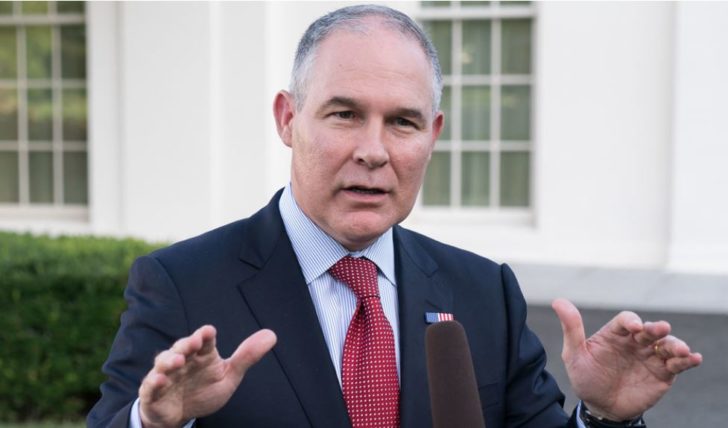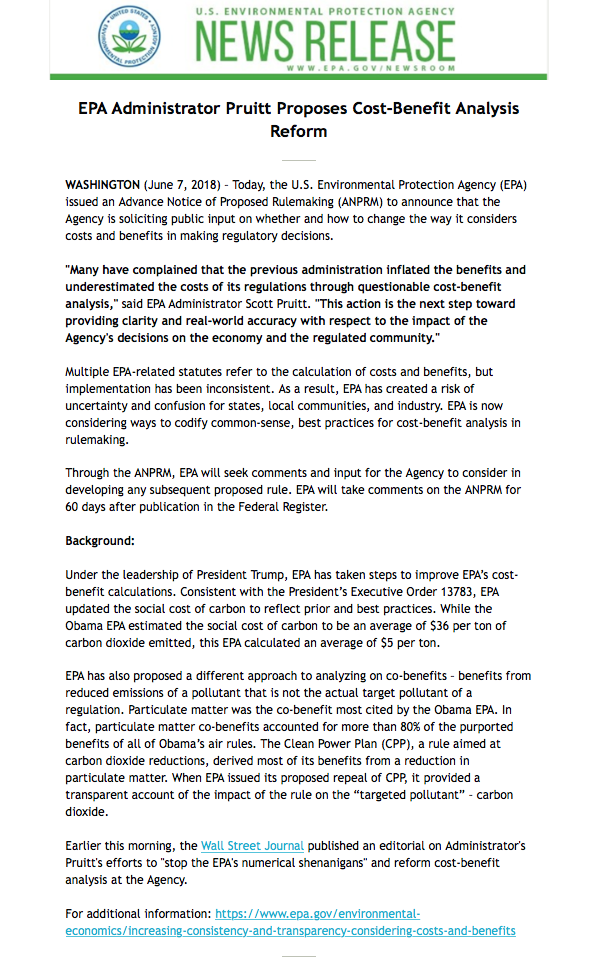Thank you, Administrator Scott Pruitt — greatest EPA chief ever.

Below is the EPA media release and cited Wall Street Journal editorial.

###
Cost-Benefit Reform at the EPA
Under Obama, the EPA juked the numbers to justify costly regulation.
By The Editorial Board
June 6, 2018, Wall Street Journal
Barack Obama’s Environmental Protection Agency jammed through an average of 565 new rules each year during the Obama Presidency, imposing the highest regulatory costs of any agency. It pulled off this regulatory spree in part by gaming cost-benefit analysis to downplay the consequences of its major environmental rules. The Trump Administration has already rolled back some of this overregulation, and now Administrator Scott Pruitt wants to stop the EPA’s numerical shenanigans, too.
On Thursday the EPA will take the first step toward a comprehensive cost-benefit reform by issuing an advance notice of proposed rule-making. After weighing public input, EPA will propose a rule establishing an agency-wide standard for how regulations are assessed. The reform would make it easier for Americans and their elected representatives to see whether more regulation is truly justifiable.
The EPA has a statutory obligation to look at the costs and benefits of many proposed rules. That responsibility has been reinforced by executive orders and court rulings. But while all three branches of government have supported such assessments, they leave the EPA broad discretion. Enter the Obama Administration, which saw the chance to add additional considerations to the cost-benefit equation.
By introducing “social costs” and “social benefits,” the EPA began factoring in speculation about how regulatory inaction would affect everything from rising sea levels to pediatric asthma. EPA optimists even included their guesses about how domestic regulations could have a global impact. Meanwhile, the agency ignored best practices from the Office of Management and Budget, juking the numbers to raise the cost of carbon emissions.
This proved as politically useful as it was scientifically imprecise. Months before introducing the Clean Power Plan, the EPA suddenly raised the social cost of a ton of carbon emissions to an average of $36 from $21. Before it embarked on new oil and gas regulations, the EPA put the social cost of methane at an average of $1,100 per ton.
At White House direction, the Trump EPA recalculated those figures last year to include only demonstrable domestic benefits. The social cost estimates dropped to an average of $5 per ton of carbon and $150 per ton of methane. That made a big difference in the cost-benefit analysis. While the Obama Administration claimed the Clean Power Plan would yield up to $43 billion in net benefits by 2030, the Trump EPA concluded it would carry a $13 billion net cost.
Another statistical sleight of hand involves the Mercury and Air Toxics Standards. The regulation’s stated purpose was to reduce mercury pollution, but the EPA added the rule’s potential to decrease dust. That was irrelevant to the central question of whether it was worthwhile to regulate mercury as proposed. But without the erroneous co-benefits, EPA would find such regulations tougher to justify.
On his first day in office, Mr. Pruitt said his goal was to protect the environment and the economy, and that “we don’t have to choose between the two.” His many ethics controversies have distracted from that mission, but this cost-benefit reform is a welcome return.
The regulatory specifics will be hashed out in the coming months, but there’s real potential here to curb the distortions that mask bad policy. If Mr. Pruitt succeeds, future cost-benefit analyses will be more consistent and transparent. The reform would help to ensure regulation is based on sound scientific analysis instead of wishful bureaucratic thinking.
Appeared in the June 7, 2018, print edition.